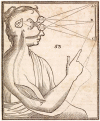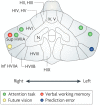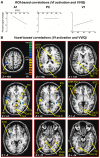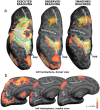The Action Cycle Theory of Perception and Mental Imagery
- PMID: 36810316
- PMCID: PMC9944880
- DOI: 10.3390/vision7010012
The Action Cycle Theory of Perception and Mental Imagery
Abstract
The Action Cycle Theory (ACT) is an enactive theory of the perception and a mental imagery system that is comprised of six modules: Schemata, Objects, Actions, Affect, Goals and Others' Behavior. The evidence supporting these six connected modules is reviewed in light of research on mental imagery vividness. The six modules and their interconnections receive empirical support from a wide range of studies. All six modules of perception and mental imagery are influenced by individual differences in vividness. Real-world applications of ACT show interesting potential to improve human wellbeing in both healthy people and patients. Mental imagery can be applied in creative ways to make new collective goals and actions for change that are necessary to maximize the future prospects of the planet.
Keywords: Action Cycle Theory; VVIQ; action; affect; individual differences; mental imagery; neuroscience; perception; schemata; vividness.
Conflict of interest statement
The author declares no conflict of interest.
Figures








Similar articles
-
I Am Conscious, Therefore, I Am: Imagery, Affect, Action, and a General Theory of Behavior.Brain Sci. 2019 May 10;9(5):107. doi: 10.3390/brainsci9050107. Brain Sci. 2019. PMID: 31083483 Free PMC article. Review.
-
Internal consistency and construct validity of two versions of the Revised Vividness of Visual Imagery Questionnaire.Percept Mot Skills. 2011 Oct;113(2):454-60. doi: 10.2466/04.22.PMS.113.5.454-460. Percept Mot Skills. 2011. PMID: 22185060
-
The Relationship Between Vividness of Positive Future-Oriented Mental Imagery, Anhedonia, and Positive Affect.Psychol Rep. 2025 Apr 20:332941251335587. doi: 10.1177/00332941251335587. Online ahead of print. Psychol Rep. 2025. PMID: 40253646
-
Meta-analytic comparison of trial- versus questionnaire-based vividness reportability across behavioral, cognitive and neural measurements of imagery.Neurosci Conscious. 2017 Apr 22;2017(1):nix006. doi: 10.1093/nc/nix006. eCollection 2017. Neurosci Conscious. 2017. PMID: 30042840 Free PMC article.
-
What is the Relation between Chemosensory Perception and Chemosensory Mental Imagery?Multisens Res. 2024 Aug 27:1-30. doi: 10.1163/22134808-bja10130. Online ahead of print. Multisens Res. 2024. PMID: 39191424 Review.
Cited by
-
Stronger Short-Term Memory, Larger Hippocampi and Area V1 in People with High VVIQ Scores.Vision (Basel). 2025 Jul 7;9(3):53. doi: 10.3390/vision9030053. Vision (Basel). 2025. PMID: 40700081 Free PMC article.
-
Phenomenological Studies of Visual Mental Imagery: A Review and Synthesis of Historical Datasets.Vision (Basel). 2023 Oct 20;7(4):67. doi: 10.3390/vision7040067. Vision (Basel). 2023. PMID: 37873895 Free PMC article. Review.
References
-
- Descartes R. Principles of Philosophy. Simon and Shuster; New York, NY, USA: 2012. 1644.
-
- von Helmholtz H. Treatise on Physiological Optics. Volume III. Courier Corporation; Chelmsford, MA, USA: 2013. p. 209. Translated from the Third German Edition Edited by James P. C. Southall.
-
- Bruner J.S., Postman L. Emotional selectivity in perception and reaction. J. Personal. 1947;16:69–77. doi: 10.1111/j.1467-6494.1947.tb01076.x. - DOI
Publication types
LinkOut - more resources
Full Text Sources

